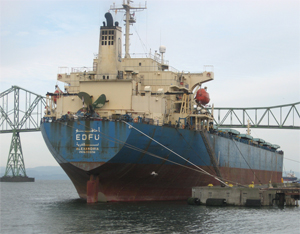A dry-bulk carrier's visit to Washington to load grain turned into a six-week ordeal that included two propulsion losses, detainment, an injured crewman and the loss of three anchors.
The Panamax bulk ship Edfu's crew struggled to overcome the multiple casualties and delays, including the engine repairs and rebuilding of its inadequate firefighting system.
 |
|
The Egyptian-flagged Edfu is moored at Astoria, Ore., while awaiting Coast Guard approval to sail. The dry bulk carrier was detained for multiple safety deficiencies after a propulsion failure at the entrance to the Columbia River. (Peter Marsh photo) |
The 733-foot vessel's first sign of trouble occurred on the morning of Oct. 11, 2011, when its engine stopped just outside the Columbia River Bar, the U.S. Coast Guard said. The 71,500-deadweight-ton ship was inbound from Korea in ballast. Technicians determined that a blockage in the fuel system stalled the engine on the Egyptian-flagged vessel.
The wind was 17 to 20 mph with strong gusts, and seas were 12 to 14 feet. The crew walked out their only anchor in 40 fathoms (240 feet) depth, eight miles southwest of the Cape Disappointment lighthouse, paying out 900 feet of chain. The other anchor had been lost in bad weather at the previous port of call.
Edfu was carrying 98,000 gallons of bunker fuel and 2,700 gallons of diesel, so the Washington Department of Ecology was notified that there was the threat of an oil spill.
On the evening of Oct. 11, Capt. Bruce Jones, commander of Coast Guard Sector Columbia River, issued a Captain of the Port order calling tugs of adequate size and horsepower to the scene. On Oct. 12, a class surveyor from Lloyd's Register of Shipping was flown out and lowered to Edfu's deck by the Columbia River Bar Pilots' helicopter.
After the surveyor had approved the repair, the ship officers followed an order to demonstrate engine function by circling in the area overnight. Edfu was given permission to enter the river Oct. 13. At 0700, the conditions had moderated and the helicopter returned and landed a bar pilot. The vessel crossed the bar, escorted by the Sause tug Natoma and the Foss tug Pacific Explorer. It moored at the Port of Astoria, Ore., at 0930 without further incident.
Inspectors from Coast Guard Marine Safety Unit Portland boarded Edfu to conduct a follow-up Port State Control exam. They discovered numerous deficiencies including an un-serviceable firefighting system due to cracked and deteriorated piping, improper stowage of oil residue on deck, excessive oil in the engine room and failure of the ship to implement its security plan. Jones issued a second order detaining Edfu until all safety and security measures were corrected.
"Edfu's failure to comply with numerous provisions of the SOLAS (Safety of Life At Sea) Convention, the ISPS (International Ship and Port Facility Security) Code and the ISM (International Safety Management) Code are unacceptable," he said.
Columbia Metal Works, a mobile repair specialist, was hired. The condition of the engine — a B&W 6S60MC, 11,830 hp/8,700 kW — was approved by Lloyd's. The Coast Guard revisited the vessel and was satisfied with its condition.
After 17 days alongside, the ship was permitted to anchor off Astoria to wait for a loading berth in Kalama, Wash. On Nov. 1, Edfu personnel called the Coast Guard from the anchorage reporting a crewmember with an eye injury. Station Cape Disappointment launched a 47-foot motor lifeboat that transported the crewman to Columbia Memorial Hospital in Astoria. He was treated and released.
Neither the Coast Guard nor the ship operator would disclose the cause of the eye injury.
Edfu loaded in Kalama and was finally ready to sail to Tacoma, Wash., on Nov. 10. The ship was outbound and had reached the mouth of the Columbia when a high-temperature alarm sounded in the engine room, according to the Washington Department of Ecology.
The engine was shut down to prevent catastrophic failure and both anchors were dropped in the shipping channel, which is maintained at a minimum depth of 45 feet. Due to excessive way on the vessel and a 5-knot ebb current, the chain could not take the strain and both anchors were lost just south of Cape Disappointment lighthouse.
The ship drifted out into the Pacific where the fault was identified as a clogged sea chest, lube oil cooler and auxiliary engine strainers. The engines were restarted and back on line 22 minutes later, and Edfu turned north on course for Puget Sound and Tacoma.
The Coast Guard ordered another tug escort to Tacoma. The Dahl tug Triton was dispatched from the lower Columbia, while the Foss tug Lindsey Foss departed from Puget Sound.
In Tacoma, Edfu underwent further investigation by the Coast Guard. Lloyd's attended to certify repair of the strainers. The ship underwent full replacement of anchors and anchor chain.
Edfu was built in 1997, and is one of 18 vessels owned and operated by National Navigation Co., based in Cairo, Egypt. The company declined to comment.
The ship did successfully deliver its cargo to Qingdao, China.
